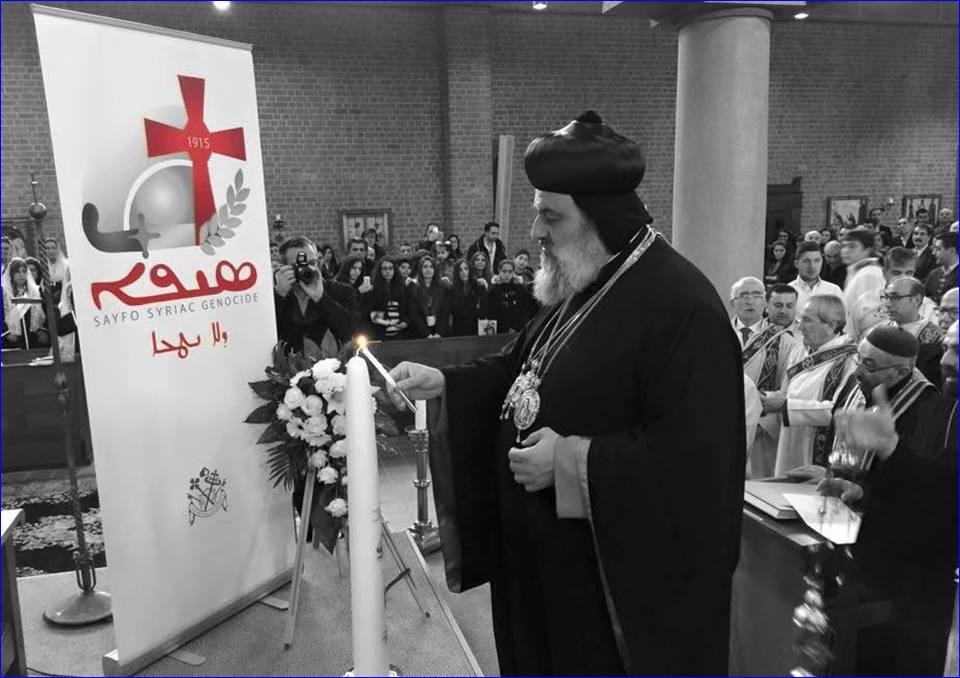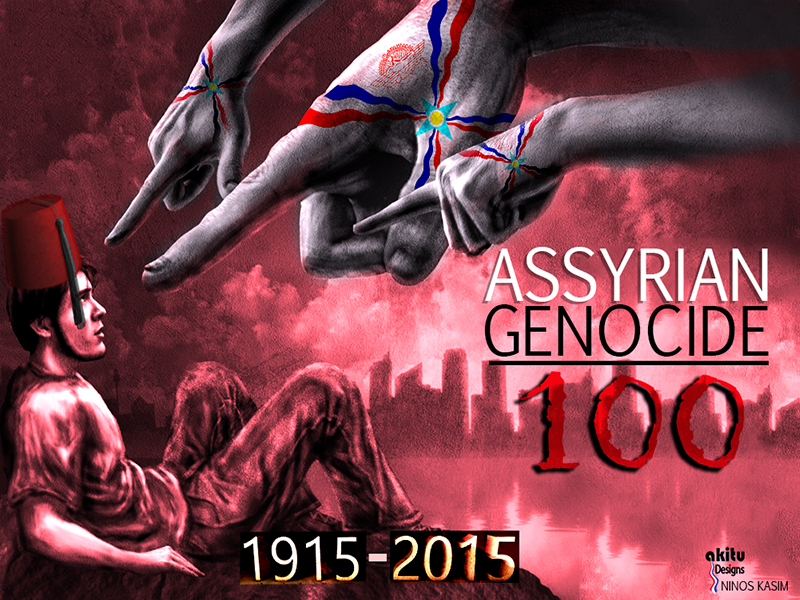


The Plan
The Young Turks came to power in the Ottoman Empire in a coup d'état on 24 July 1908, effectively deposing Sultan Abdul-Hamid II. Once they seized power, they proceeded to systematically replace old Ottoman bureaucrats with young Muslims, fired with the passion to create Turan -- a Turkic state stretching from the Adriatic to the Great Wall of China.
At the Annual Congress of the Young Turks' Committee for Union and Progress (CUP) in Thessaloniki in 1910, the Congress' President remarked that, "no reliance could be placed" upon Christians, and "... as Europe always regarded the affairs of Turkey through Christian spectacles every effort must be made to crush the propaganda of the Empire's Christian nationalities, which might attract the attention of European politicians... Musulmans generally should retain their arms, and where they are in a minority arms should be distributed to them by the authorities... Emigration [of Muslims] from the Caucasus and Turkestan must be encouraged, land provided for the immigrants, and the Christians prevented from purchasing property... Sooner or later the complete Ottomanization of all Turkish subjects must be effected, but it was becoming clear that this could never be achieved by persuasion, and recourse must be had to force of arms."
At the following year's Congress, again held in Thessaloniki, chaired by Talaat Pasha, Ottoman Interior Minister, one of their chief ideologues, Dr. Bahaettin Sakir, told the assembly, "The nations that remain from the old times in our empire are akin to foreign and harmful weeds that must be uprooted. To clear our land..." So, the indigenous Christian peoples of Asia Minor, including the Assyrians, became "foreign and harmful weeds that must be uprooted" from their own homelands. By 1914, the extreme wing of the CUP was in complete control of the Ottoman bureaucracy and military.
The Opportunity
The opportunity to execute this plan came in the form of World War I, which began in late July 1914. On August 1, the Ottoman Empire signed a secret alliance treaty with Germany, which declared war on Russia that same day. On November 1, the Ottoman Empire officially entered the First World War, with Russia's declaration of war against them, at the same time declaring a Holy War (Jihad) against the Christian powers. Even before the War had begun, however, the Ottoman Government was planning and ordering the uprooting and destruction of its Christian population.

On August 3rd, Tahsin Pasha, the Ottoman governor of Van, arranged a meeting with the Assyrian Church of the East patriarch Mar Binyamen Shim'on, where a number of promises were made to keep the Assyrians of that province neutral and loyal to the Ottoman State. In exchange for the establishment of schools, roads and infrastructure in their areas, the Church's prelates were entrusted with the collection of aid for the Ottoman military's mobilisation (Seferberlik). At the same time, soldiers were being conscripted from amongst the Assyrians around Van, whose homes were being plundered in the name of collecting aid for the army. From that month onwards, Assyrians in districts bordering Iran were began to flee from violent raids by the Ottoman military, which was reportedly arming Kurdish tribesmen while confiscating weapons from Assyrians. As the survivors attempted to flee their attackers, they were captured, tortured and brutally slain. Wholesale massacres of unarmed Assyrian villagers by Ottoman troops were also being reported.
Wholesale Slaughter
The Ottoman policy of destruction soon extended into the neighbouring Persian Empire (modern-day Iran). On 24 December 1914, Ottoman War Minister Enver Pasha implemented a plan to encircle and destroy the Russian Army at Sarikamis in order to regain territories formerly lost to them. Enver's forces were routed in the battle, and almost completely destroyed, with the blame laid on Armenians fighting for the Russians. As a result, retreating troops under Jevdet Bey embarked on a military incursion into the Assyrian districts of Urmia and Salamas in Iranian Azerbaijan at the beginning of 1915. Unarmed Assyrians were massacred, died of hunger or disease, thousands of girls as young as seven were raped or forcibly converted to Islam, and 200 Christian villages were destroyed, with three quarters of them burned to the ground. Jevdet is reported to have held a meeting in February 1915 at which he said, "We have cleansed the Armenians and Syrians from Azerbaijan, and we will do the same in Van."
On 29 May 1915, the Temporary Law of Deportation was passed, giving the Ottoman government and military authorization to deport anyone it "sensed" as a threat to national security. With its implementation, the confiscation of Christian property and widespread slaughter ensued. Armed resistance to forced conscription and deportation were subsequently labelled as "revolts" by the government. The killings and mass starvation were thus "systematic," "authorized" and "organized by the government." From statements by Talaat Pasha, it is clear that officials were aware that the deportation order was genocidal.
In mid-1915, Jevdet Bey entered the towns of Bitlis and Siirt with 8,000 soldiers whom he named "The Butchers' Battalion," ordering the massacre of Armenians and almost 20,000 Assyrian civilians in at least 30 villages. Eyewitness accounts describe the systematic process used. First, the community leaders were imprisoned and tortured to death, followed by the arrest of all young and able-bodied men, who were taken some distance from the city and shot. This was followed by the rounding up of male children, who were taken to a nearby cliff and thrown into the valley below. Finally, women, girls and the elderly were deported, only to be attacked by Kurdish tribes who robbed and murdered them.
German Ambassador Hans Freiherr von Wangenheim reported that the Ottoman Empire was being "clear[ed]" of its indigenous Christians by "eliminat[ion]." In July 1915, he confirmed that the Assyrians of Midyat, Nisibis, and Jazirah were also slain. Assyrian survivors, from many villages in the Tur-'Abdin region, flocked to centres such as 'Ayn-Wardo, Azakh and Binebil, where they put up fierce resistance to attacks by Ottoman troops. The Assyrians of Tur-'Abdin still refer to 1915 as the year of Sayfo, or the sword.
Deportation and Expropriation
A number of Assyrians, alongside Armenians, were marched out to the Syrian town of Deir ez-Zor and its surrounding desert. There is no evidence that the Ottoman government provided the facilities and supplies that would have been necessary to sustain the life of the hundreds of thousands of deportees during or after their forced marches. Henry Morgenthau wrote that, "When the Turkish authorities gave the orders for these deportations, they were merely giving the death warrant to a whole race; they understood this well, and, in their conversations with me, they made no particular attempt to conceal the fact ..." By August 1915, The New York Times reported that the roads and the Euphrates River were strewn with corpses of exiles, and those who survived were doomed to certain death. Talaat Pasha and Jemal Pasha were completely aware that by abandoning the deportees in the desert they were condemning them to certain death.
The deportations were accompanied by other heinous crimes. Civil populations of Assyrians were shut up in churches and burned -- the first gas chambers -- or tortured to death. Assyrians and Armenians from Diyarbakir were also taken on rafts down the Tigris River, which were then capsized, drowning them. The shortest method, however, for disposing of the deportee women and children was to burn them. On 13 September 1915, the new "Temporary Law of Expropriation and Confiscation" was passed, stating that all properties and assets, including land, livestock, and homes left behind by deported Armenians, was to be confiscated by the authorities. Through this, the Ottoman government took possession of all "abandoned" Christian goods and properties, even selling them in many cases.
Ethnic Cleansing and Extermination
The Assyrians of the Hakkari highlands also resisted Ottoman forces and allied Kurdish tribesmen. They were not going to be an easy group to deport, as they had always been armed, and were just as ferocious as their Kurdish neighbours. On 12 April 1915, an assembly of Assyrian tribal leaders, under the leadership of Patriarch Mar Benyamen Shim'on, decided to enter an understanding with Russia, owing to the needless attacks on Assyrian villages and the oppressive environment that their inhabitants continued to live in. On 23 June 1915, the Ottoman Governor of Mosul advanced his forces, along with Kurdish irregulars, and attacked the southernmost of the Assyrian tribes, forcing them further into the mountains. They were often cut off in small pockets, vastly outnumbered and surrounded, however, with unarmed villagers making easy targets for Ottoman and Kurdish forces. They were finally defeated on 15 September, and the surviving refugees flooded across the border into Persia.
It was the assassination of Mar Benyamin Shim'on on 3 March 1918 by Kurdish chieftain Simko that eventually led, on 3 July, to the epic exodus of 90,000 Assyrians and Armenians. Travelling some 800 kilometres over 6 weeks in helter-skelter panic, with their families, livestock and possessions, they were decimated by unremitting attacks on all flanks by Turks, Kurds and Persians. None of those captured were spared. Persian commander Majd-ul-Saltane on two occasions cut off the retreat of the refugees, and telegraphed that he had that day, "sent 2,000 infidels to hell." Scorched by the heat of summer, and ravaged by Typhus, dysentery, smallpox and cholera, children and elderly alike, fully spent by fatigue and fever were abandoned along the route. It is estimated that the Assyrians alone lost over 25,000 people on this march, and fewer than 50,000 survivors reached the Ba'quba refugee camp in British-administered Mesopotamia (now Iraq).
Some 17,000 Assyrians remained stranded at Urmia when it was re-occupied by Ottoman forces, unable to flee in time. Most found refuge in mission compounds, with over 6,000 crowding the French Catholic mission and thousands more in the American mission compound. After the mass-wave of killing in the first week had subsided, it was found that roughly 1,100 Assyrians managed to escape being murdered, including 60 who had survived from the French mission and 800 that remained at the American mission. Many of these were later killed and dispersed.
Aftermath and Conclusion
The First World War formally ended with the Armistice on 11 November 1918. The Ottoman Empire had surrendered to the Allies twelve days earlier. The end of the "Great War," however did not mean the end of the Genocide. The policy of extermination was continued by the heirs of the Ottoman Empire between 1919 and 1923, during the Turkish War of Independence, as well as between 1924 and 1925, after the formal establishment of the modern Republic of Turkey.
The 1920 Treaty of Sèvres called the Ottoman regime "terrorist" and contained provisions "to repair so far as possible the wrongs inflicted on individuals in the course of the massacres perpetrated in Turkey during the war." It also provided for the full protection of Assyro-Chaldeans. This treaty, however, was never ratified and was ultimately replaced by that of Lausanne in 1923, which finally brought peace to Asia Minor. It was accompanied by a "Declaration of Amnesty," without containing any provision in respect to punishment of war crimes. It also did not include the Assyrians as an official minority and, as a result, the Turkish State has since ignored their rights.
Dr. Nicholas Al-Jeloo is currently a lecturer at the School of Historical and Philosophical Studies, University of Melbourne, specialising in Syriac Studies. He is additionally affiliated with the Syriac Language Research Centre at the University of Divinity. Dr. Al-Jeloo is a socio-cultural historian with expertise in indigenous Middle Eastern Minorities, Eastern Christianity, the history of the Middle East and Islamic World, as well as interfaith and intercultural relations.

or register to post a comment.